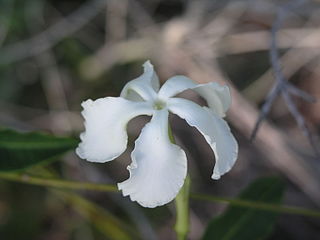| Temnadenia | |
|---|---|
 | |
| Temnadenia odorifera | |
| Scientific classification | |
| Kingdom: | Plantae |
| Clade: | Tracheophytes |
| Clade: | Angiosperms |
| Clade: | Eudicots |
| Clade: | Asterids |
| Order: | Gentianales |
| Family: | Apocynaceae |
| Subfamily: | Apocynoideae |
| Tribe: | Echiteae |
| Genus: | Temnadenia Miers |
Temnadenia is a genus of flowering plants in the family Apocynaceae, first described as a genus in 1878. It is native to South America. [1] [2]
- Species [1]
- Temnadenia odorifera (Vell.) J.F.Morales - Brazil
- Temnadenia ornata (Hoehne) Woodson - Bolivia, Peru, W Brazil
- Temnadenia stenantha Woodson - Boyacá region of Colombia
- Temnadenia violacea (Vell.) Miers - Brazil
- formerly included [1]
- Temnadenia annularis = Prestonia annularis
- Temnadenia cordata = Mandevilla oaxacana
- Temnadenia corrugulata = Prestonia solanifolia
- Temnadenia glaucescens = Mandevilla oaxacana
- Temnadenia lasiocarpa = Mandevilla hirsuta
- Temnadenia leptoloba = Prestonia quinquangularis
- Temnadenia lobbiana = Mandevilla hirsuta
- Temnadenia meyeri = Macropharynx meyeri
- Temnadenia palustris = Mandevilla hirsuta
- Temnadenia parviflora = Prestonia parviflora
- Temnadenia quinquangularis = Prestonia quinquangularis
- Temnadenia riedelii = Prestonia riedelii
- Temnadenia secundiflora = Mandevilla subsagittata
- Temnadenia semidigyna = Echites semidigynus
- Temnadenia solanifolia = Prestonia solanifolia
- Temnadenia tenuicula = Prestonia solanifolia
- Temnadenia tomentosa = Mandevilla hirsuta
- Temnadenia xanthostoma = Mandevilla coccinea












